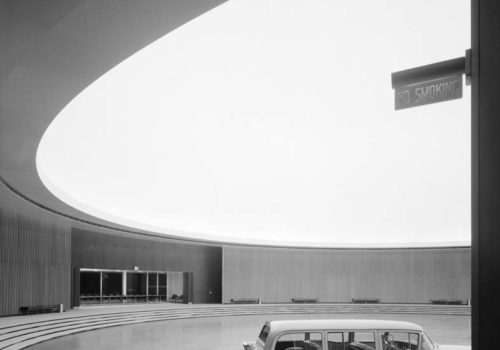Yossi Milo Gallery presents works by Takuma Nakahira, Simen Johan, Chris McCaw, Pieter Hugo, Ezra Stoller, Alison Rossiter, Mike Brodie, Matthew Brandt, Yuki Onodera and Sze Tsung Leong.
Takuma Nakahira’s series, Circulation: Date, Place, Events, was first presented in 1971 as part of the Seventh Paris Biennale. For five consecutive days, Nakahira photographed, developed and exhibited approximately one hundred photographs daily. The images are random glimpses from Nakahira’s daily activities in the city of Paris, including strangers’ faces, produce stands, subway platforms, street posters and his breakfast setting. The resulting experimental project presents a limited reality dictated by guidelines of “date,” “place” and “events.”
Simen Johan’s ongoing series, Until the Kingdom Comes, depicts animals in an unsettling natural world hovering between reality and fantasy. The artist merges traditional photographic techniques with digital methods. Having originally photographed a variety of plants and animals in natural preserves, zoos, farms, museum dioramas or in his own studio, the artist then places these elements digitally into new environments constructed from images photographed elsewhere. Johan blurs the boundaries between opposing forces, such as the familiar and the otherworldly, the natural and the artificial, the serene and the eerie. Exploring paradoxes, the artist situates his images between an ideal paradise and a reality complicated by desires, fears and darker instincts. For Paris Photo Los Angeles, Yossi Milo Gallery will present the newest edition to the series, a large-scale photograph of a mysterious, misty landscape populated by giraffes.
Chris McCaw builds his own large-format cameras and outfits them with powerful lenses for his Sunburned series. Instead of film, McCaw inserts expired vintage, fiber-based gelatin silver photo paper directly into the camera and aims the lens at the sun. Long exposures magnify the sun’s rays, which literally burn through or sear the sun’s path across the surface of the paper while creating a solarized image of the landscape or seascape. McCaw uses the most basic elements of the medium, light and time, to create his unique photographs that recall the work of photography pioneer Henry Fox Talbot and pays homage to the “slash” and “hole” paintings of Minimalist artist Lucio Fontana.
Pieter Hugo’s series, Permanent Error, depicts a technological wasteland in Ghana. On the outskirts of a slum known as Agbogbloshie lie piles of discarded computers and electronic parts, many of which were donated by the UN in their effort to close the digital divide. Amid the toxic scene, Mr. Hugo takes portraits of young people who make their living by burning down the plastics of old wires, disks and monitors to extract the metals inside.
Ezra Stoller (American, 1915-2004) is known as one of the most influential photographers of modern architecture. He created iconic photographs of mid-century buildings that help define the cultural memory of structures such as Louis Kahn’s Salk Institute, Frank Lloyd Wright’s Marin County Civic Center and Robert Law Weed and Associates’ Miami Parking Garage. Ezra Stoller, Photographer was published in December 2012 by Yale University Press, which includes rarely seen black-and-white images of industry, technology, transportation and working-class Americans, as well as photographs in color that have been selected from the Stoller archive.
Alison Rossiter’s photographs are created without a camera on expired, vintage photo paper. The artist collects and experiments with gelatin silver papers that date from the early 1900s through the 1970s, making controlled marks by pouring or pooling photographic developer directly onto the surface of the paper. Abstract forms emerge, which sometimes resemble landscapes or are paired by the artist to create minimalist collages. Rossiter’s newly created quadriptychs, composed of four unique sheets dipped into developer at angles, are reminiscent of Ellsworth Kelly paintings.
Mike Brodie’s series of color photographs, A Period of Juvenile Prosperity, documents the gritty youth subculture of train hoppers and squatters as they traverse North America via railroad. Working under the moniker The Polaroid Kidd, Brodie shot the series while traveling the rails over a five-year period. Through intimate portraits set against ever-changing landscapes, Brodie captures the raw reality of his travels: the dirt, the blood, the struggles and ultimately, a community of tattooed travelers who share the challenges and triumphs of life on the road. In March, Twin Palms Publishers released a monograph of the series A Period of Juvenile Prosperity.
Matthew Brandt’s Dust photographs condense time by recreating historical images with remnants of the present. Brandt researches historical photographs of buildings being demolished in public library databases. The artist selects certain demolition images, such as the Burbank City Hall and the Melrose Hotel, and receives digital files which he uses to create large-scale negatives. He then visits the location of the original building and collects dust from the structure currently situated on the lot. Dust collected from each site is used as the pigment in handmade gum-bichromate emulsion with which the artist creates prints. Brandt uses the same gum-bichromate process to depict contemporary buildings, such as the Morgan Stanley Tower and the Caloptima City Parkway. Using dust collected from a particular floor or suite inside, Brandt creates prints depicting the facades of the building.
Sze Tsung Leong’s series of color photographs, Horizons, depicts expansive views of a broad spectrum of environments throughout the world. The locations of the images may be distant in geography and diverse in subject matter, yet the photographs are linked by a common horizon which continues in the same position from image to image. When placed side by side, the images form an extended landscape composed of an accumulation of varied continents, cities, terrains, situations, textures and colors.
Yuki Onodera’s series Look out the Window depicts houses in the suburbs of Tokyo photographed at night. The small homes, built in the passing trends of European or Scandanavian design, are defined by light from the illuminated windows. Through painstaking masking work in the dark room, the artist creates glowing boxes of light that seem to float in the darkness.
















